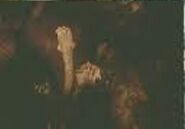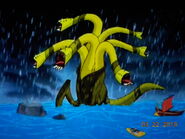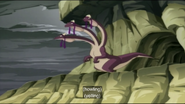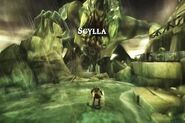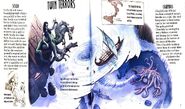Scylla (Greek: Σκύλλα: Skylla), is a four-eyed, six-headed monster, with three rows of teeth per head, from Greek mythology. She appears in Homer's Odyssey.
Myths & Legends
The monster lived on one side of a narrow channel of water, thought to be the Strait of Messina, separating mainland Italy from Sicily. Her counterpart is Charybdis, a whirlpool-like sea monster that consumed water and ships alike. The two sides of the strait were within an arrow's range of each other—so close that sailors attempting to avoid Charybdis would pass too close to Scylla and vice versa. The idiom "between Scylla and Charybdis", refers to this situation of choosing between two evils.
Her habits are also described slightly differently throughout Greek mythology. In some myths, Scylla will only eat any random six sailors, while other myths say that she will relentlessly attack the ship by quickly devouring the sailors.
Appearance
Scylla had six ugly heads with three rows of sharp teeth on the end of long, flexible necks which she used to snatch up sailors. Her body was said to have consisted of twelve tentacle-like legs and a cat's tail, with four snapping dog heads encircled her waist.
Sometimes Scylla is depicted as a large, angry woman with ravenous dogs instead of legs. Other times, it is described as a creature with many snake-like heads.
The Odyssey
In Homer's The Odyssey, the Scylla was a vicious sea monster that patrolled one side of the Straits of Messina (sometimes known as the Roving Rocks) and attempted to eat sailors on ships who pass through.
Ships passing through the Straight of Messina/Roving Rocks between Sicily and Italy had a choice; sail closer to Scylla, or closer to her partner, Charybdis. If they chose Scylla, then she would snatch up six sailors, one for each head, from the deck of the ship. (Any attempt to cheat her would result in her picking up the whole ship and bringing it to her lair.) Charybdis, the whirlpool, would swallow thousands of gallons of seawater at random times and then belch the water back out an unspecified time later. If a ship was caught here at the wrong time, it would be swallowed whole.
Circe advised Odysseus to sail closer to Scylla. He did so and lost six men, but was able to continue his journey home.
Family
Originally a nymph, some place her as a daughter of Phorcys and Ceto while others name Triton and Lamia as her parents. According to Hyginus she was beloved of the god Glaucus, who was himself desired by the sorceress Circe.
Transformation
Scylla had once been a beautiful sea nymph, and different stories tell of her transformation. In some stories, she boasted her beauty and compared it to the Gods. In another tale Circe tricked her lover into poisoning her out of jealousy. She poisoned her rival's bath waters, but she herself was turned into a ravenous monster instead. In other tales, she was pursued by Poseidon, whose wife Amphitrite transformed her.
Modern Depictions
Films
Animations
Video games
As a Race
Scyllas are also kind of dog-headed mermaids in Greek mythology and later became octopi in modern media and that identical to cecaeliae but females only and more demonic.



